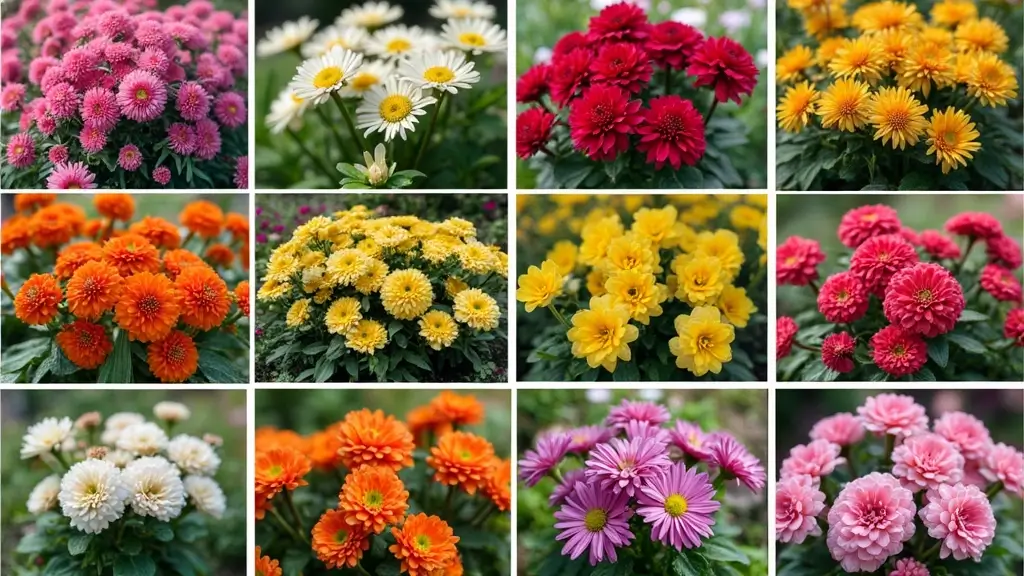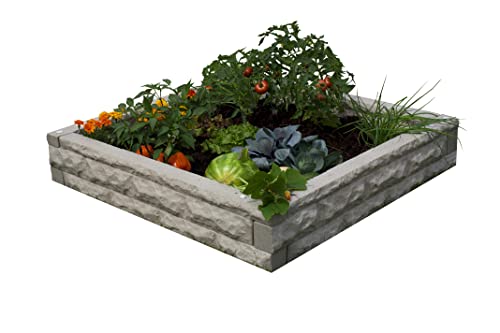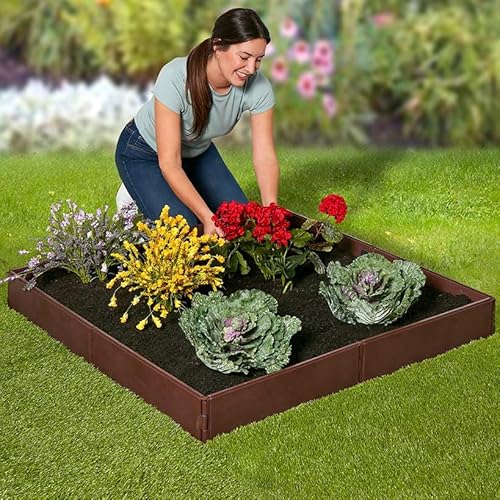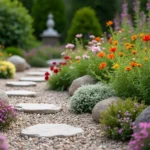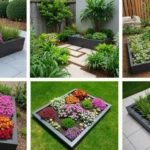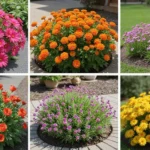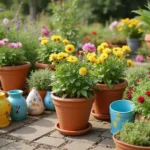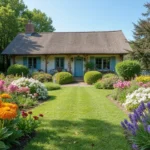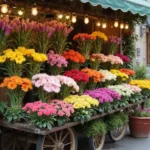Transforming your garden into a vibrant oasis doesn’t have to be a daunting task.
With the right selection of perennials and a little thoughtful planning, you can create stunning flower beds that are as beautiful as they are low-maintenance.
In this collection, we’ve curated 30 garden flower bed ideas that are perfect for adding a splash of color to your yard while ensuring easy upkeep.
Whether you’re a seasoned gardener or just starting out, these inspiring designs will help you cultivate a landscape that’s bursting with life and beauty.
1. Perennial Paradise
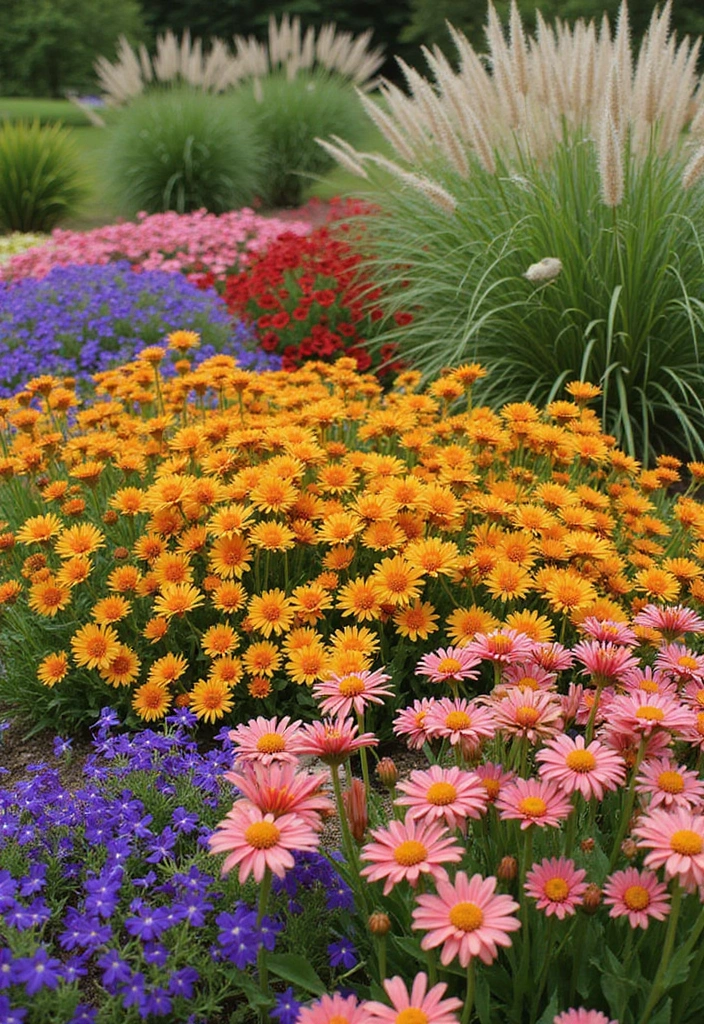
Perennials are the backbone of any low-maintenance garden flower bed. Imagine a mix of daylilies, coneflowers, and salvias just blooming away year after year, with little need for care.
This type of flower bed design is perfect for creating a lush backdrop with layers of color and texture. For best results, group your plants in odd numbers to create a more natural look.
Mixing in some ornamental grasses can add height and movement to your bed. Consider using flowers that bloom in succession to ensure your garden remains vibrant throughout the seasons.
Tips:
– Plant taller perennials at the back of the bed and shorter ones in front.
– Incorporate mulch to retain moisture and suppress weeds.
– Choose a color palette that complements your home’s exterior.
With these tips, you can create a perennial paradise that keeps giving.
Create your own Perennial Paradise! With daylilies, coneflowers, and salvias, your low-maintenance garden flower bed will bloom year after year, inviting color and joy into your yard with minimal effort.
2. The Color Wheel
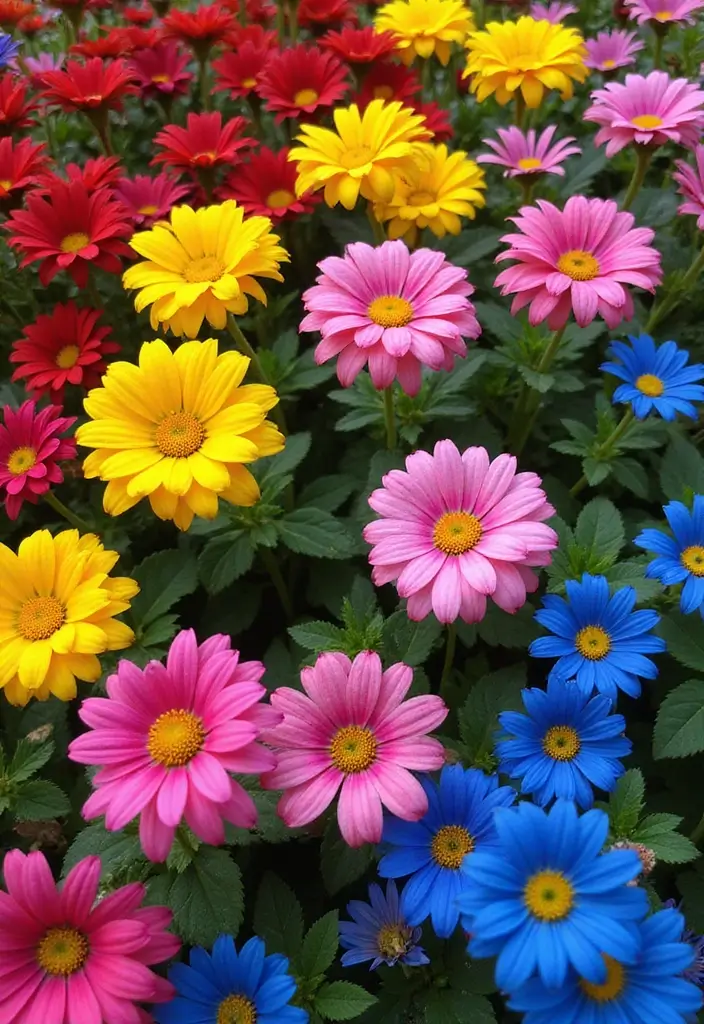
Take a page from the artist’s playbook by designing a flower bed based on the color wheel.
Start with a base of bold colors like red and yellow and transition into softer shades such as pinks and blues. This gradient effect will create a stunning visual that draws the eye.
Use flowers like zinnias, petunias, and phlox to bring your palette to life.
Consider mixing in some dark green foliage to provide contrast and make your colors pop even more.
Suggestions:
– Use annuals for instant color while your perennials grow.
– Create a focal point with a standout flower species.
– Don’t forget the importance of texture; mix smooth and fuzzy leaves.
This way, your garden will resemble a painter’s canvas, bursting with life!
3. Cottage Charm
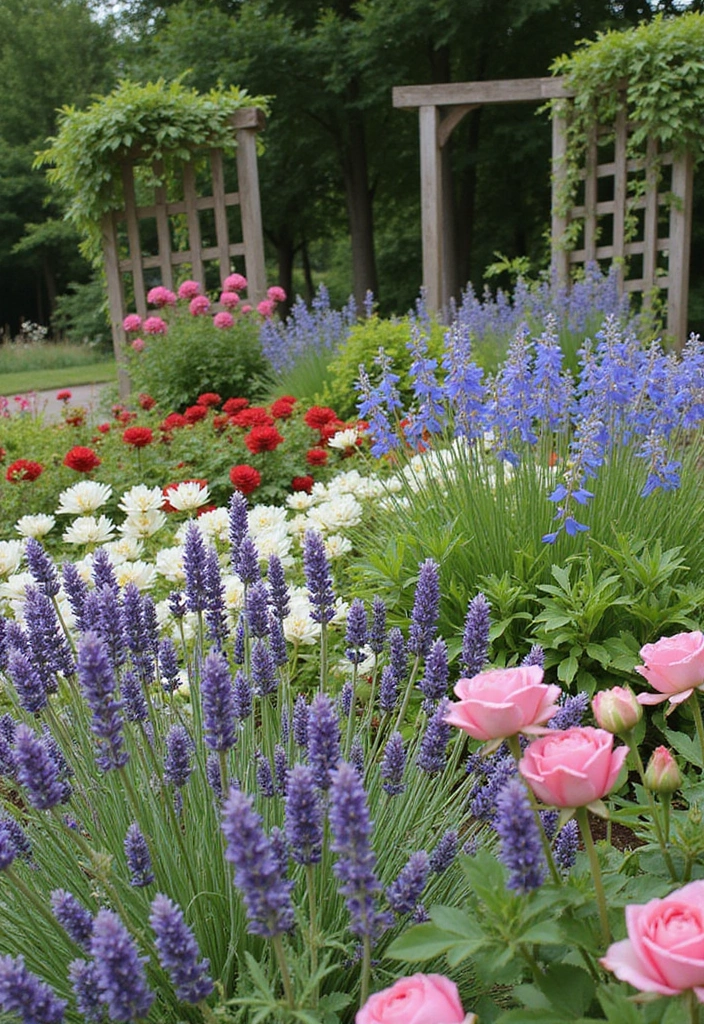
For a dreamy and nostalgic feel, incorporate a cottage garden style into your flower bed design.
Think of lavender, roses, and delphiniums mingling together in a mesmerizing display.
The key to this look is a slightly chaotic arrangement where flowers seem to spill over paths and intermingle freely.
Add a few rustic elements like wooden trellises or whimsical garden art for that extra touch.
Tips:
– Choose a variety of heights and colors to create depth.
– Incorporate herbs like basil or thyme for fragrance and utility.
– Allow some plants to overlap pathways for a relaxed, informal look.
With these elements, your garden will feel like a storybook scene.
4. Zen Garden Retreat
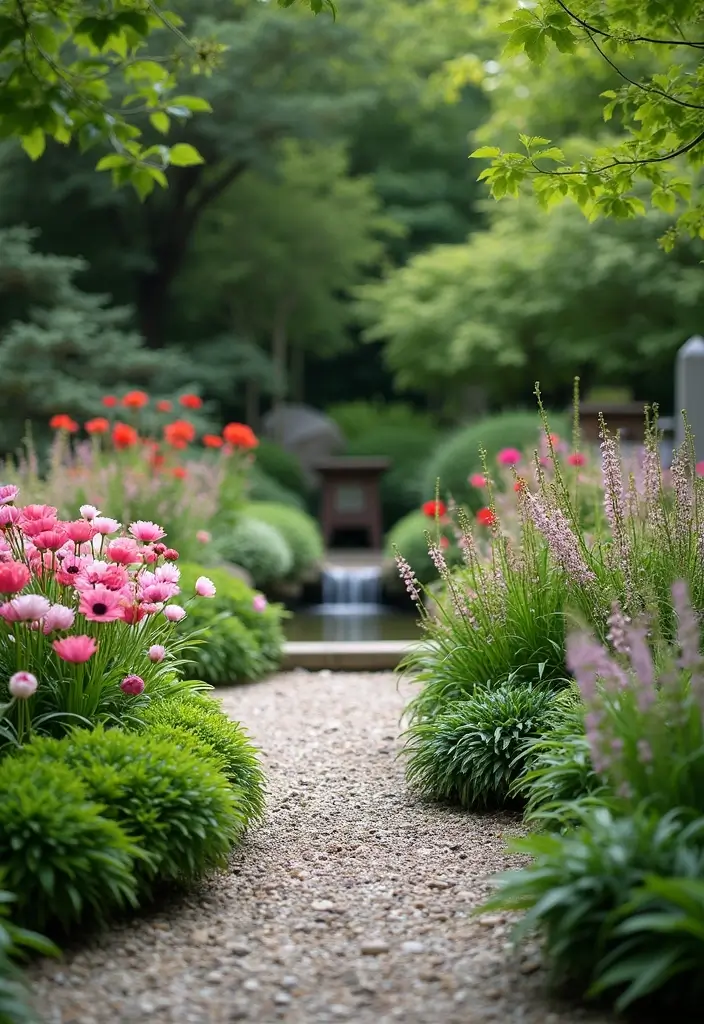
Create a tranquil oasis with a Zen garden flower bed that emphasizes peacefulness and simplicity.
Consider using plants like Japanese anemones, hostas, and astilbes that thrive in shaded areas.
Incorporate gravel or river stones to form clean lines and pathways, allowing the flowers to stand out.
Use large boulders or sculptures to build focal points, which can enhance the serene atmosphere.
Suggestions:
– Aim for a limited color palette to harmonize the space.
– Add a small water feature for a soothing soundscape.
– Use benches or seating areas for meditation or reflection.
This design can be your ultimate escape in your own backyard.
Embrace tranquility in your garden! A Zen flower bed with Japanese anemones and soothing stones can turn your outdoor space into a peaceful retreat. Create your oasis today!
5. Drought-Resistant Delight
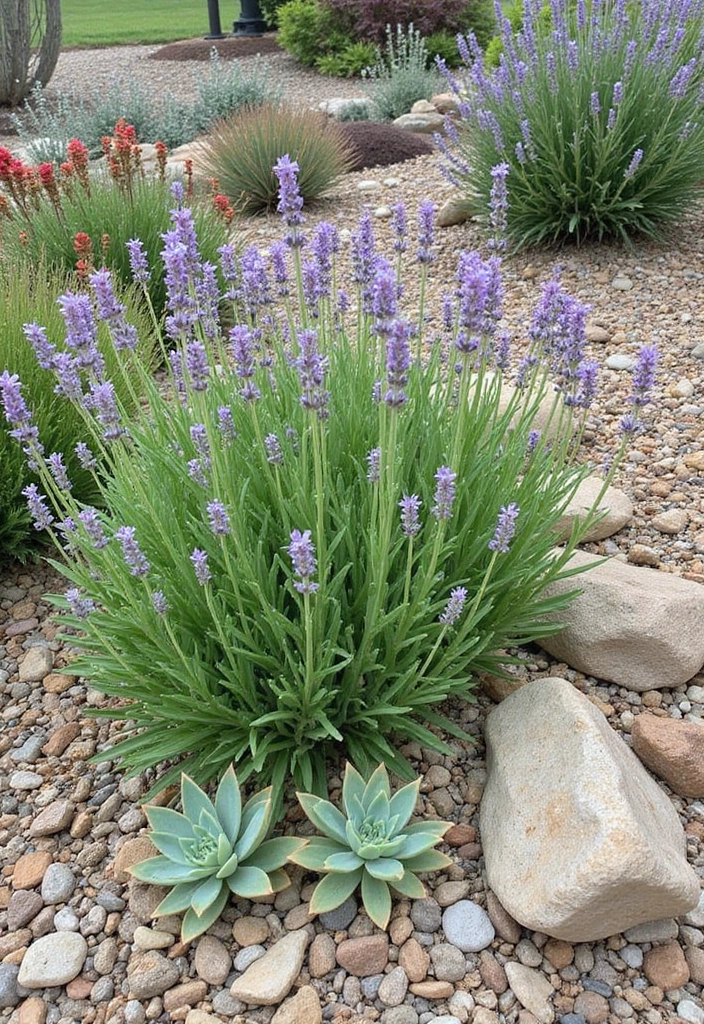
If your garden struggles with water retention, consider a drought-resistant flower bed using plants that thrive in arid conditions.
Succulents, lavender, and yarrow not only survive the heat but can also add wonderful textures and colors to your space.
Arrange them in clusters for a more visually appealing look, and integrate rocks or gravel as ground cover.
Include a drip irrigation system to maintain moisture levels without overwatering.
Tips:
– Choose native plants, as they are well-adapted to local climates.
– Layer different heights for added visual interest.
– Mulching can help conserve soil moisture.
This flower bed will not only save water but will be easy on maintenance!
6. Seasonal Splendor
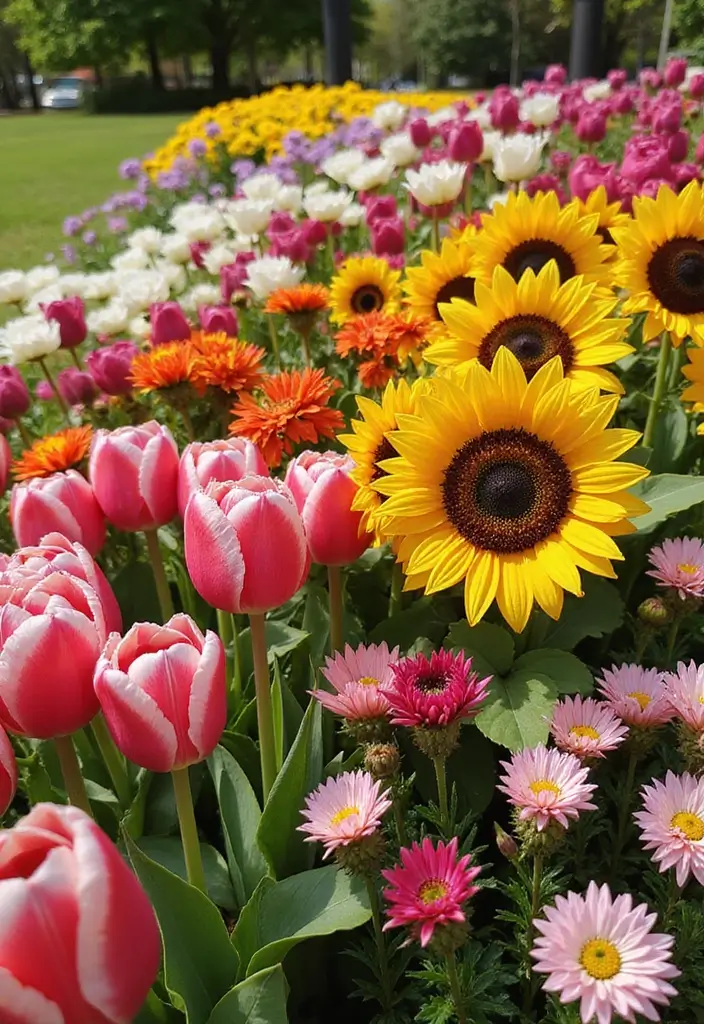
Capture the essence of changing seasons by designing a flower bed that reflects various blooms throughout the year.
Start with early spring flowers like tulips and daffodils, transitioning to summer staples like sunflowers and asters, followed by fall favorites like chrysanthemums.
Choose plants that have overlapping blooming periods to extend the show of color.
Incorporate evergreen plants for winter interest, so your garden remains visually appealing year-round.
Suggestions:
– Keep a journal to note which plants bloom when.
– Plan for color succession to keep your display vibrant.
– Don’t forget to include some winter-blooming varieties for year-round interest.
This design would allow your garden to be a canvas of colors through the changing seasons.
7. Edible Elegance
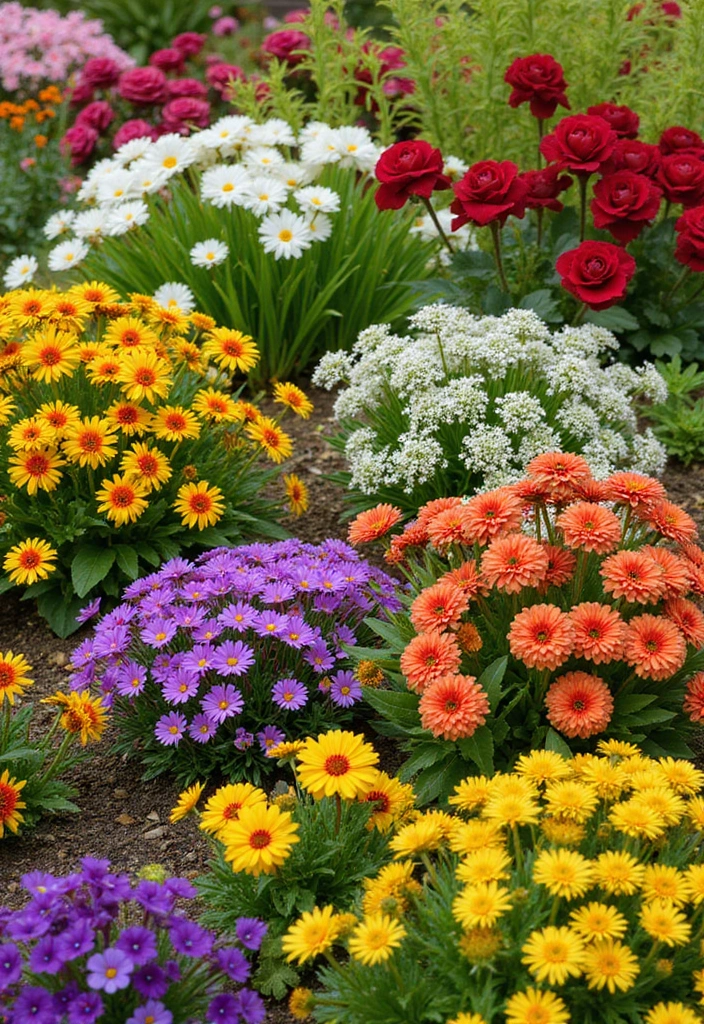
Why not mix beauty with functionality by incorporating edible plants into your flower beds?
A combination of colorful flowers and edible varieties like nasturtiums, chard, and herbs can enchant your garden while providing delightful flavors.
Plan your flower bed with consideration for sunlight, and make sure your edibles still thrive alongside your ornamental flowers.
Use herbs like rosemary and thyme as borders to add fragrance and color.
Tips:
– Choose companion plants that will benefit each other.
– Keep an eye on pests, as they might be drawn to edible plants.
– Harvest flowers and herbs for salads and garnishes.
Your garden will be a feast for both the eyes and the palate!
8. Wildflower Wonderland
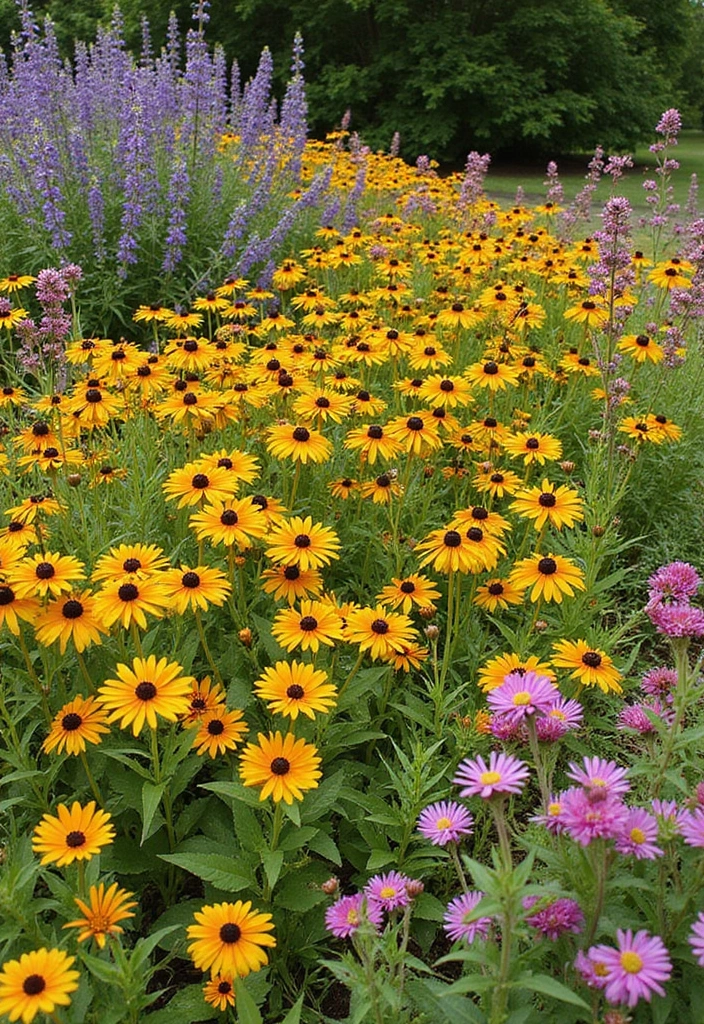
Embrace a more natural approach with a wildflower flower bed that varies in color and texture.
Planting native wildflowers not only beautifies your space but also supports local wildlife.
Choose a mix of black-eyed Susans, coreopsis, and butterfly bushes for a riot of color throughout the growing season.
This design allows for a relaxed and informal feel, as you let nature take the lead.
Suggestions:
– Leave some areas unmowed to encourage wildflower growth.
– Use a seed mix for diverse blooms.
– Maintain minimal intervention to let the wild beauty shine.
Your wildflower bed will attract bees, butterflies, and other pollinators, creating a thriving ecosystem.
9. Minimalist Magic
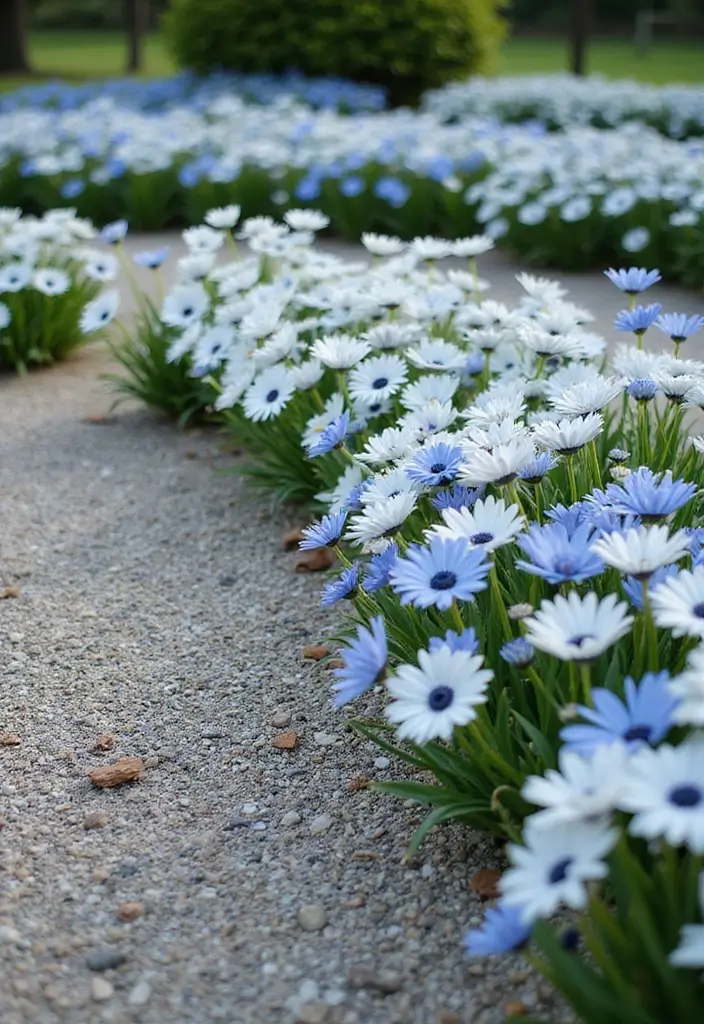
Sometimes less is more! A minimalist flower bed can have a striking impact with just a few carefully chosen plants.
Consider using monochromatic flower schemes like all white or all blue flowers, such as white peonies or bluebells, to create a serene and elegant atmosphere.
Incorporate negative space to make the plants stand out even more. Use clean lines and geometric layouts to enhance the modern feel.
Tips:
– Choose a few focal points for dramatic effect.
– Add gravel or stone paths to simplify maintenance.
– Consider container gardening for a more controlled approach.
This design will turn your flower bed into a tranquil retreat.
10. Container Creations
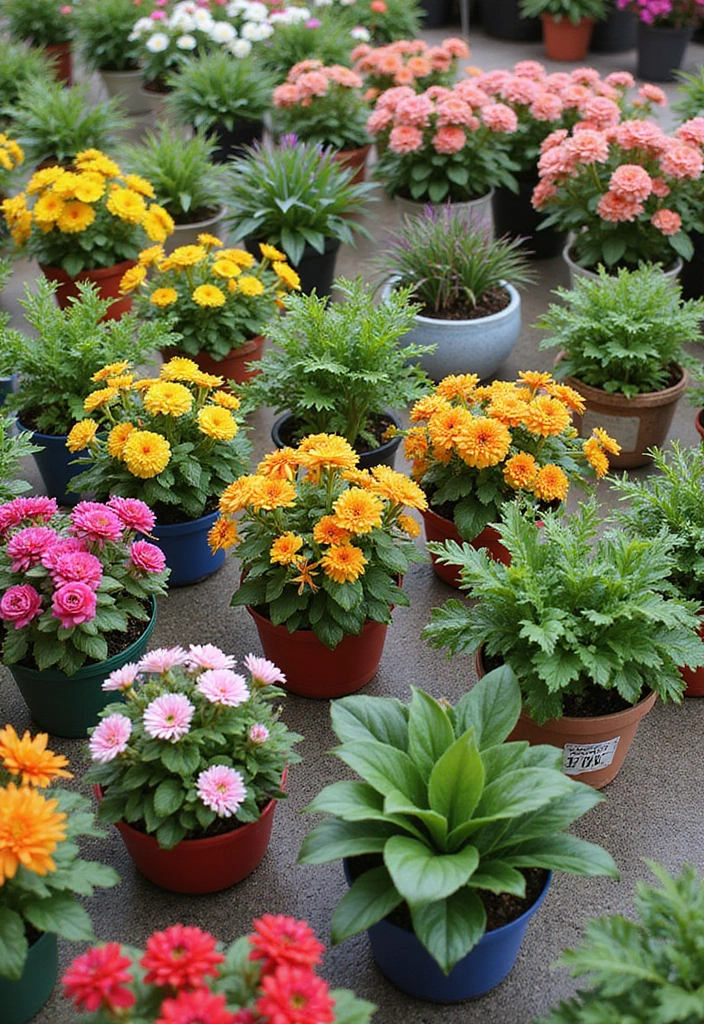
Container gardening is a great way to add bursts of color to your space without committing to a permanent flower bed.
Use a mix of annuals and perennials to create dynamic arrangements that can be updated seasonally.
Choose vibrant pots in varying heights and colors to add visual interest. Plant cascading flowers like lobelia alongside upright blooms like geraniums for a layered effect.
Suggestions:
– Place containers at varying heights for depth.
– Consider mobility; you can move containers to change your garden’s look.
– Use soil that retains moisture for best results.
With containers, the possibilities for creativity are endless!
11. Bold Borders
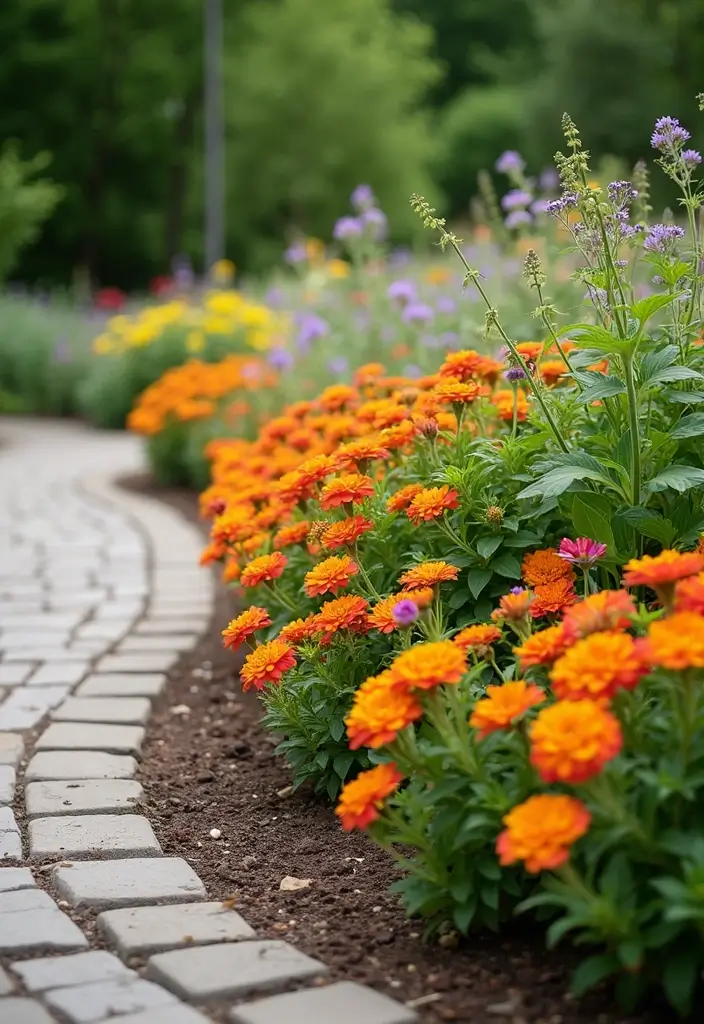
Using a border of colorful plants can define your garden spaces beautifully.
Consider using low-growing perennial flowers like pansies or sedums along pathways and around the edges of your flower beds to create a vivid frame.
This not only enhances the visual appeal but also gives the garden a polished look.
Mix various textures and colors to make the border pop.
Tips:
– Alternate flower types for a more dynamic edge.
– Use native species to ensure easy maintenance.
– Incorporate decorative stones or mulch to complete the look.
Borders can help guide the eye through your garden and provide a clear definition of space.
12. Vertical Garden Vibes
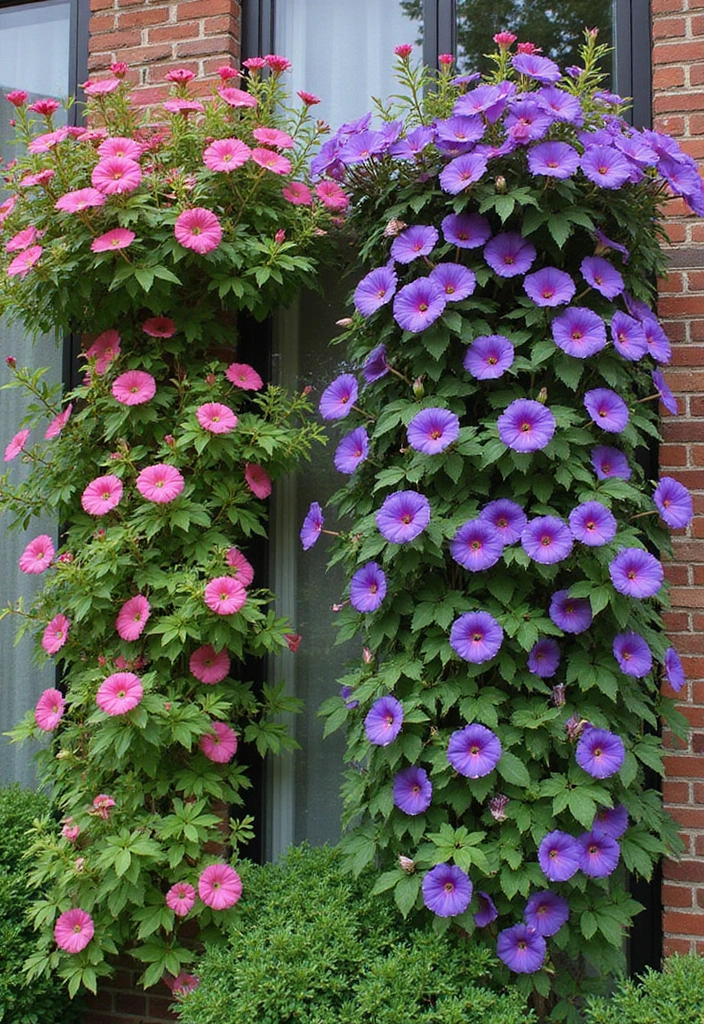
Maximize your gardening space with a vertical garden featuring cascading flowers.
Use trellises or wall planters filled with climbing plants like clematis or morning glories that will spill over your vertical structure.
This design is especially useful for small yards or patios, giving you a colorful display without taking up ground space.
Add trailing plants at the base to create a lush and full effect.
Suggestions:
– Choose a variety of heights and colors for interest.
– Regularly prune to keep plants healthy and in shape.
– Look into irrigation options for vertical setups, as they can dry out faster.
Vertical gardening is perfect for urban settings where space is limited but creativity thrives.
13. Tropical Escape
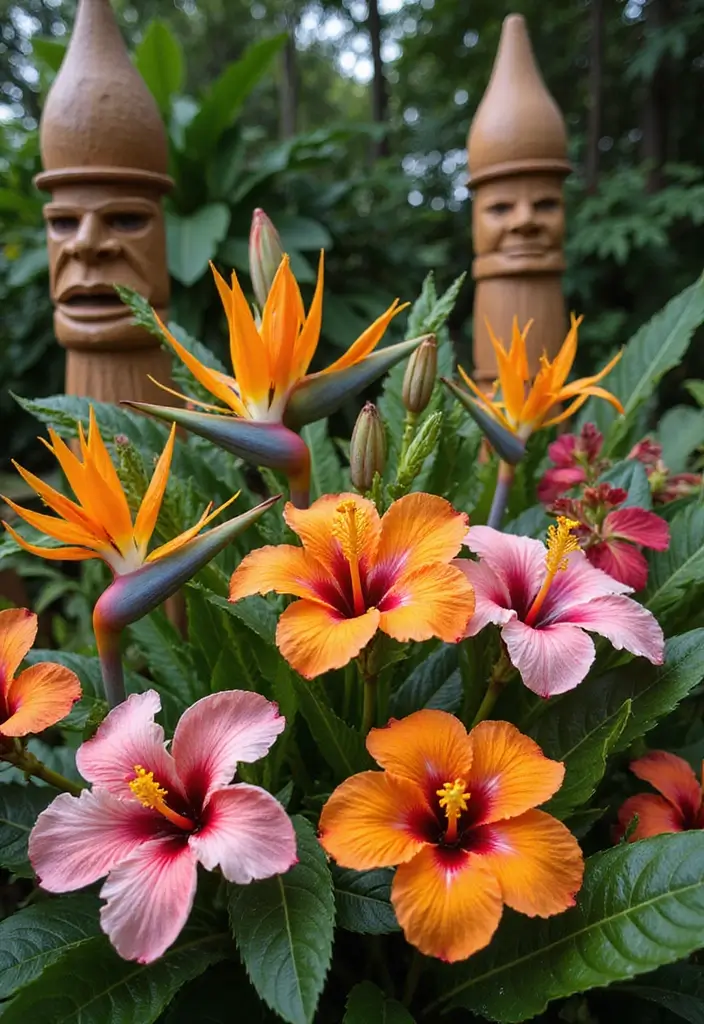
Bring a taste of the tropics to your garden with a tropical flower bed.
Incorporate bold colors and large leaves with plants like hibiscus, bird of paradise, and canna lilies.
To enhance the tropical vibe, add decorative elements like tiki torches or bamboo fencing.
Group plants to create the feel of a lush oasis where vibrant colors are the focal point.
Tips:
– Ensure your plants receive plenty of sunlight.
– Use rich soil to help retain moisture.
– Don’t forget to regularly deadhead flowers to encourage more blooms.
This design will transport you and your guests to a tropical paradise right in your backyard.
Transform your garden into a tropical escape! With bold hibiscus and vibrant canna lilies, you can create a lush oasis that shines under the sun. Let your flower bed be the colorful heart of your outdoor paradise!
14. Fragrant Fusion
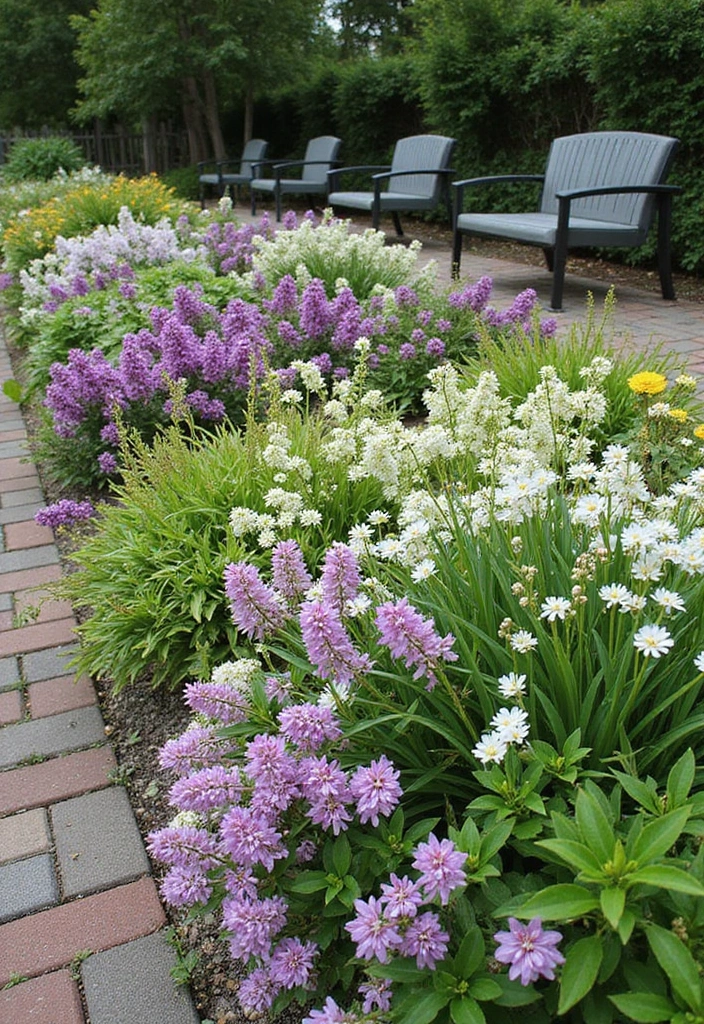
Create a sensory experience with a flower bed that highlights fragrant plants.
Consider using flowers such as jasmine, lilacs, and freesias that not only look beautiful but also smell divine.
Position these fragrant blooms near windows or seating areas, allowing their aromas to enhance your space.
Layer your plants for visual interest while ensuring that the scents can travel freely throughout the garden.
Suggestions:
– Mix in aromatic herbs like mint and basil to round out the sensory experience.
– Choose a color palette that complements the fragrances.
– Regularly prune to maintain shape and encourage growth.
This idea will take your garden’s atmosphere to new heights.
15. Rustic Roadside
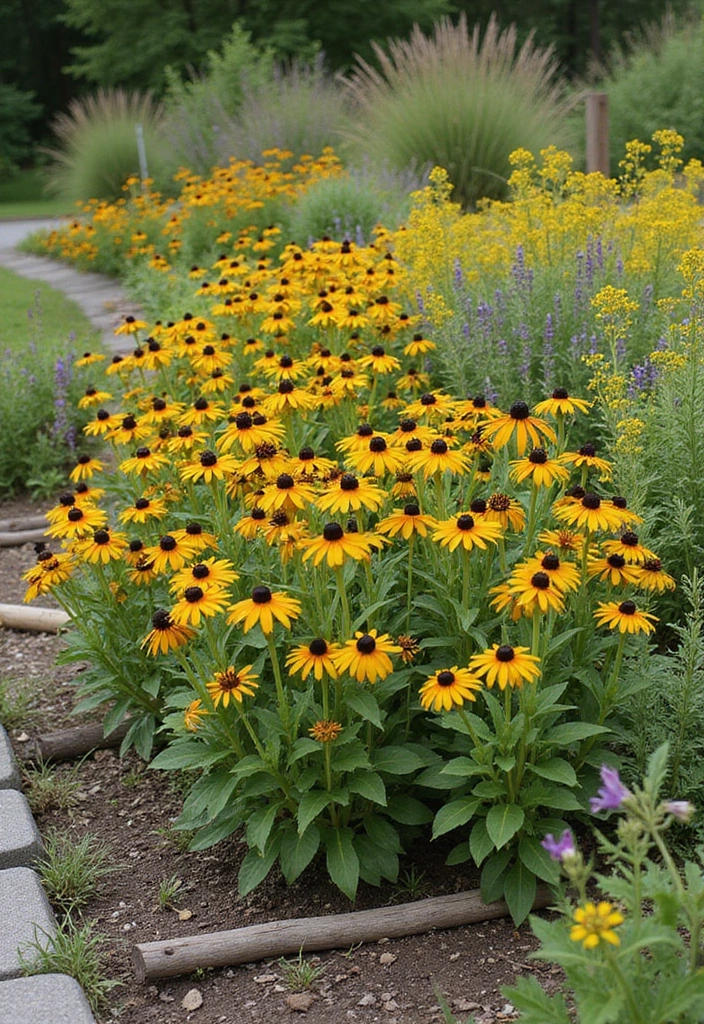
A rustic roadside flower bed can add a charming touch to your yard, inviting a bit of country flair.
Use wildflowers, tall grasses, and sturdy perennials to create a natural look. Black-eyed Susans and goldenrod will thrive and add an organic feel.
Incorporate wooden elements like fences or gates to enhance the rustic theme.
Consider creating a small path through the bed, allowing for easy access while maintaining the whimsical feel.
Tips:
– Plant in clusters for a more natural appearance.
– Use materials like stone or wood to enhance the rustic look.
– Keep maintenance minimal, allowing for that free-flowing country charm.
Your rustic roadside flower bed will be a lovely welcome to visitors.
16. Shade Lovers
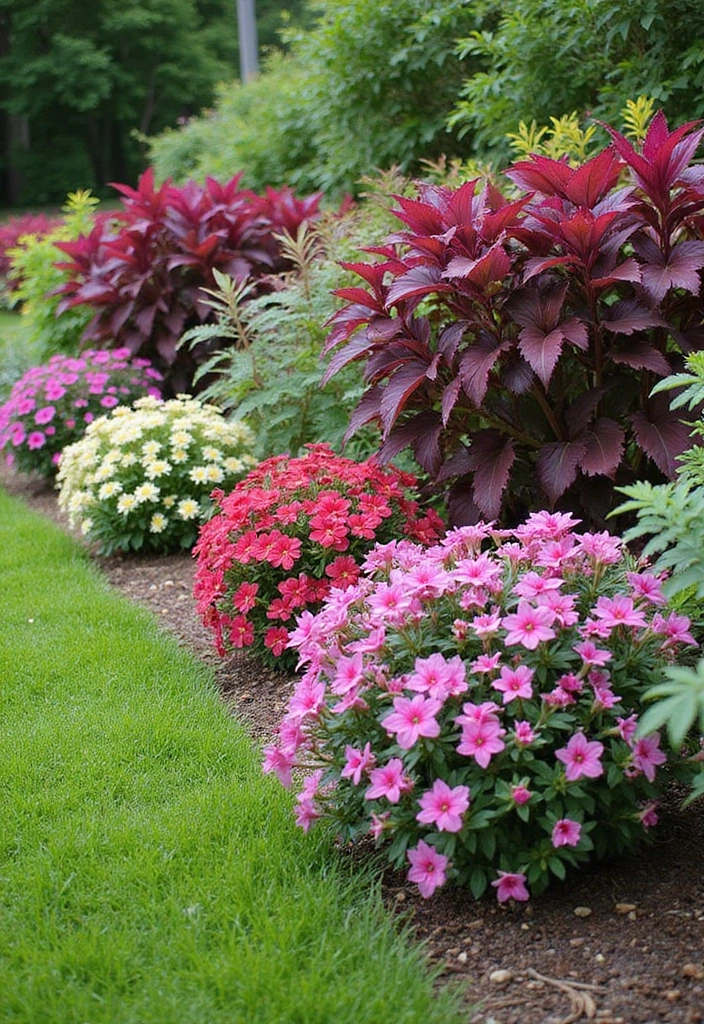
Don’t forget about shady areas in your garden! A shade-loving flower bed can be just as colorful and vibrant.
Opt for plants such as hostas, fuchsias, and heucheras that thrive in lower light but still provide a beautiful array of colors.
Layer your plants with taller ones in the back and shorter ones in front to create depth.
Consider using reflective surfaces or white flowers to brighten up darker spots.
Suggestions:
– Use mulch to retain moisture and minimize weeds.
– Mix flowers with different leaf shapes for added interest.
– Regularly check for pests that may thrive in shaded areas.
This design ensures no part of your garden is dull.
Even shady corners can bloom with beauty! Layer your shade-loving plants for a vibrant flower bed that thrives in low light and paints your garden with color.
17. Textured Tranquility
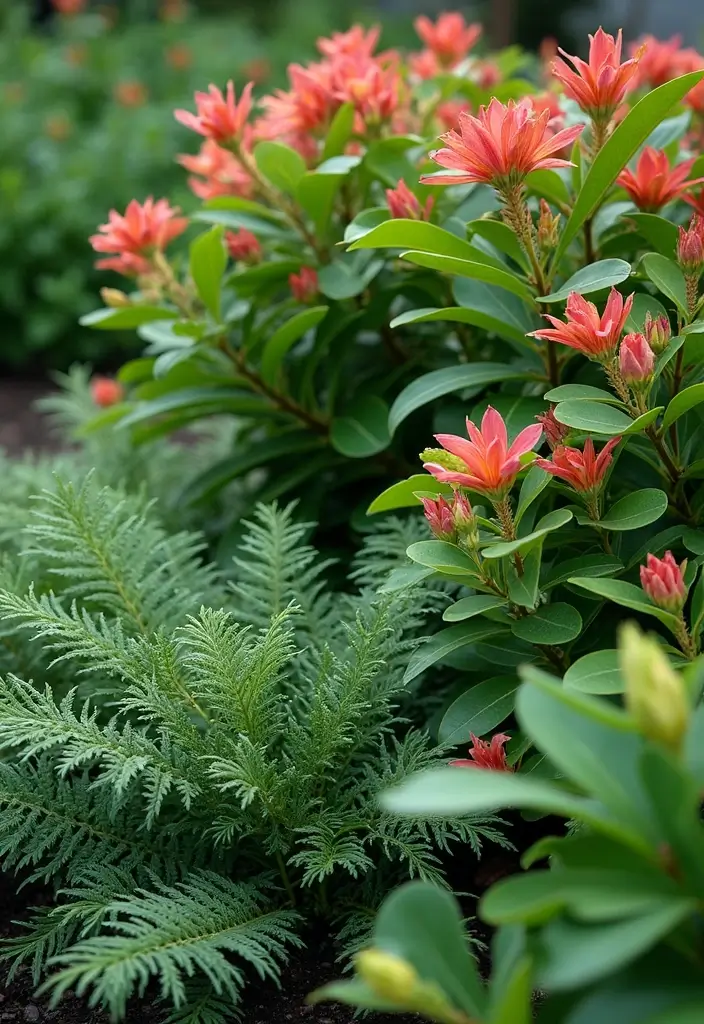
Add intrigue to your garden with a focus on texture.
Create a flower bed using a mix of plant shapes—some with broad leaves like oleander and others with fine textures like ferns.
This diversity will create a visual feast, providing interest even when flowers aren’t in bloom.
Arrange your plants to flow seamlessly from one to another, allowing for an organic look.
Tips:
– Choose a color palette that enhances texture contrasts.
– Incorporate rocks or decorative stones to add even more texture.
– Consider seasonal changes in foliage to keep interest alive throughout the year.
This approach will keep your garden feeling fresh and engaging.
18. Curved Comfort
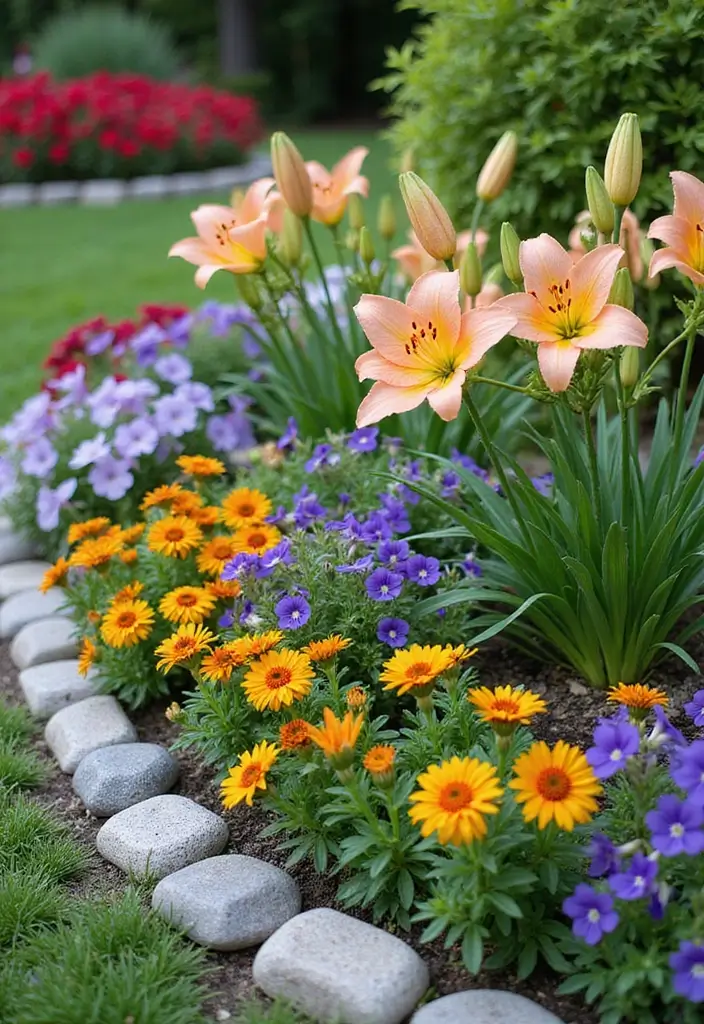
Instead of traditional straight lines, incorporate some curved designs in your flower bed layouts to add dynamism.
Curved beds can soften the appearance of hard landscapes and make your garden feel more inviting.
Consider using flowers like lilies, snapdragons, and pansies that can fill in the gentle curves beautifully.
Use edging stones or bricks to define your curves clearly while maintaining a natural look.
Suggestions:
– Fill in the gaps with ground cover plants to avoid weeds.
– Be mindful of plant heights as you design for depth.
– Regularly rotate plants for diversity.
Curved beds can make your garden feel like a cozy retreat.
19. Whimsical Wonderland
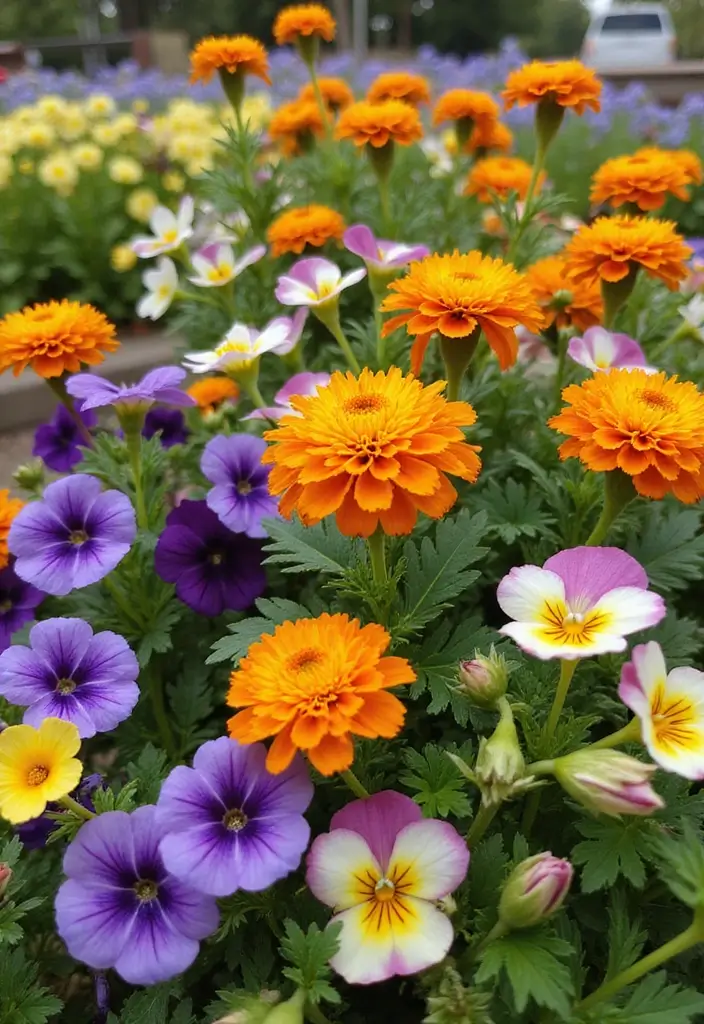
Bring your playful side out with a whimsical flower bed that features quirky shapes and fun colors.
Use plants such as marigolds, pansies, and petunias in vibrant shades.
Consider rounding off the look with decorative garden art or playful garden stakes.
Arrange plants in a non-conventional manner, perhaps creating a spiral or wave for added flair.
Tips:
– Choose a bold color palette that speaks to you.
– Incorporate playful elements like small sculptures or garden gnomes.
– Consider seasonal changes for dynamic appeal.
A whimsical flower bed can be a joy for all ages and bring a smile with every visit.
20. Cool Coastal
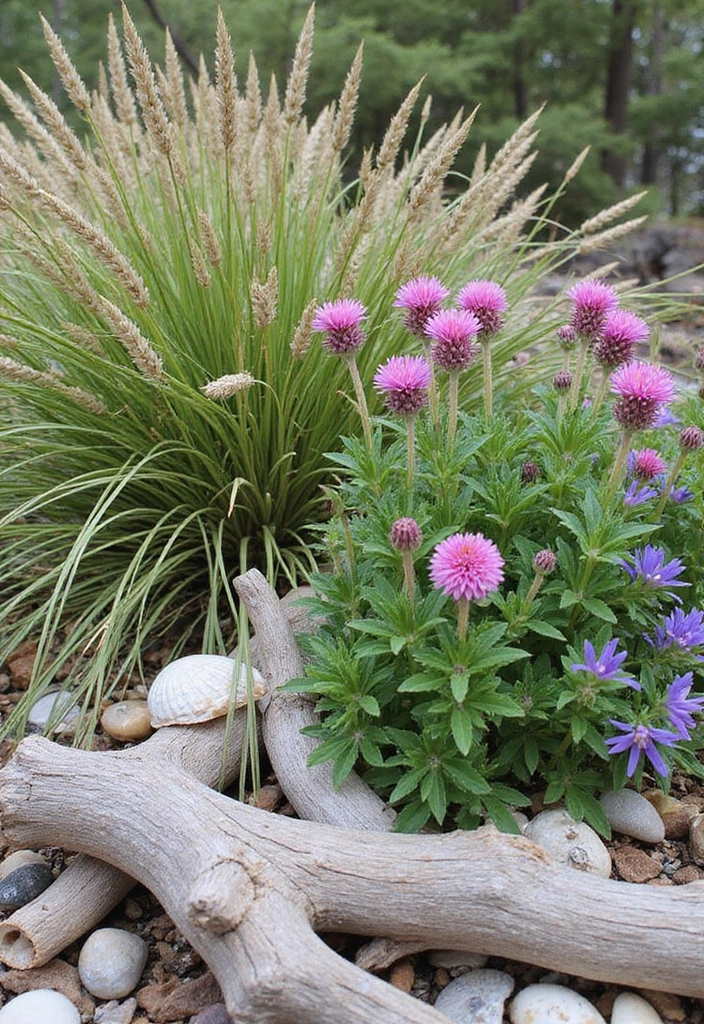
For a coastal vibe, curate a cool coastal flower bed using seaside-friendly plants.
Incorporate sea oats, beach grass, and salvia that can withstand salty air and sandy soil.
This look can be enhanced with driftwood or shells for decoration, creating a beachy aesthetic.
Group plants naturally to mimic a beach dune landscape.
Suggestions:
– Use rocks or gravel to minimize water retention issues.
– Choose native coastal plants for the best results.
– Regularly check for pests that might be attracted to the coastal environment.
Your coastal flower bed will evoke the feeling of walking along the shoreline.
21. Fairy Tale Fantasy
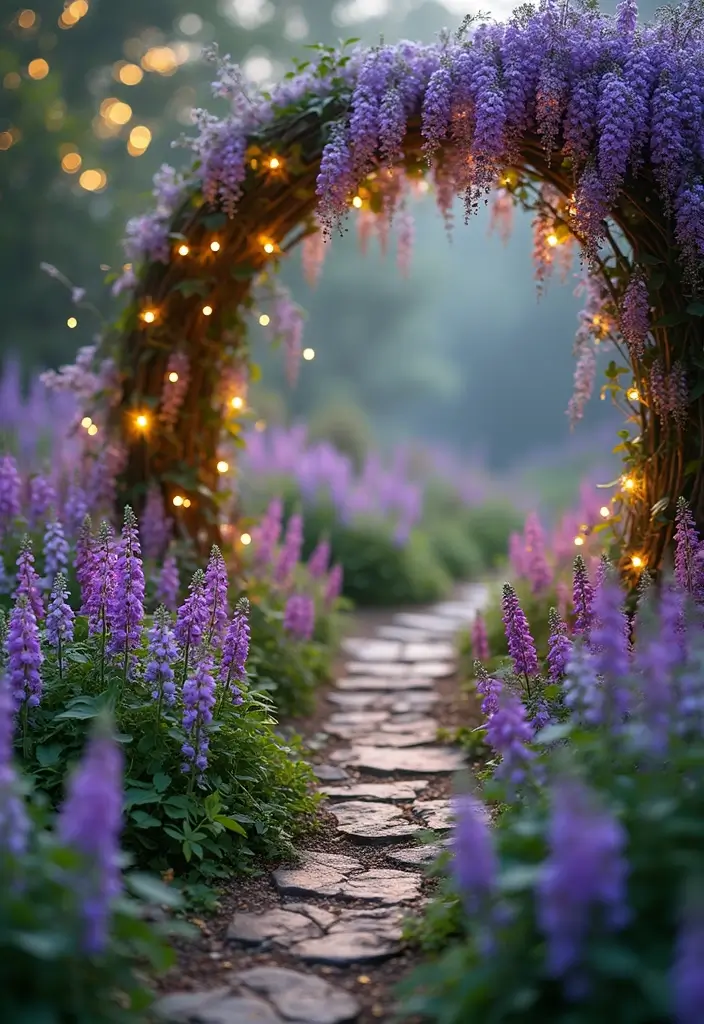
Create your very own fairy tale flower bed by incorporating enchanting plants and whimsical features.
Think about plants like wisteria for draping effects coupled with foxgloves and larkspur for height and color.
To enhance the fantasy feel, add fairy lights or small decorative figurines tucked among the blooms.
Arrange plants in a way that creates pockets of intrigue, where hidden treasures can be discovered.
Suggestions:
– Choose a mix of heights for visual drama.
– Use stones or pathways to guide visitors through the magic.
– Incorporate fragrant plants for a multi-sensory experience.
This design is bound to spark joy and wonder.
22. Urban Chic
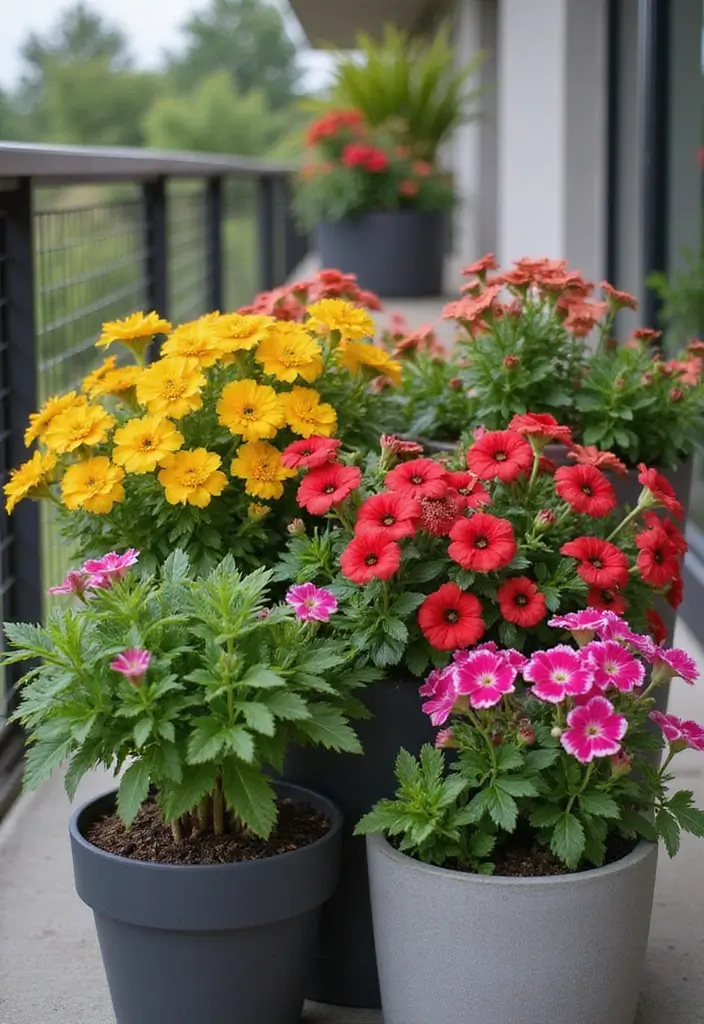
For city dwellers, creating an urban chic flower bed can bring color to concrete jungles.
Consider using container gardens or small raised beds filled with vibrant flowers like geraniums, impatiens, and petunias.
Use modern planters or recycled materials for a trendy touch.
Group arrangements on balconies or patios to maximize the urban space.
Suggestions:
– Use vertical space with wall-mounted planters.
– Opt for drought-resistant varieties to minimize maintenance.
– Change arrangements seasonally for a fresh look.
Your urban chic flower bed will bring the joy of gardening into city living.
23. Monochromatic Marvels

A monochromatic flower bed can create a striking and sophisticated look.
Choose a single color and play with different shades and textures of that hue.
For instance, using various shades of purple—like lavender, purple coneflower, and violet petunias—can create a cohesive and elegant feel.
Mixing in different heights and forms will further enhance the effect.
Suggestions:
– Use foliage plants to add depth to your design.
– Be mindful of bloom times to ensure continuous color.
– Consider seasonal adjustments for year-round interest.
This style conveys simplicity and elegance!
24. Scented Serenity
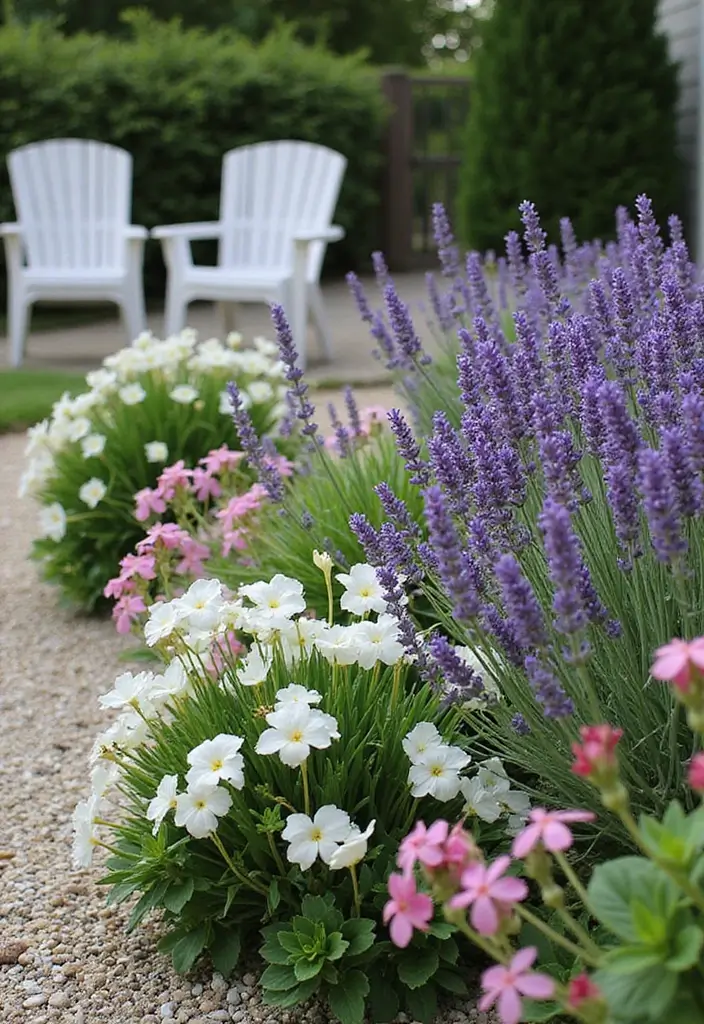
A scented serenity flower bed can be a delightful retreat.
Incorporate plants that release pleasing aromas, such as lavender, scented geraniums, and jasmine.
Position these aromatic plants near seating areas to enhance relaxation and enjoyment.
Consider planting fragrant herbs alongside them for added interest.
Tips:
– Choose colors that complement the scents for visual appeal.
– Ensure proper spacing for airflow.
– Regularly deadhead flowers to prolong blooming.
This design will not only look good but feel good too!
25. Garden Geometry

Incorporating geometric shapes in your flower bed can create a modern aesthetic.
Consider using triangular or circular layouts with flowers like rhododendrons or carnations.
This design approach emphasizes clean lines and symmetry, lending a polished look.
Add decorative stones or gravel pathways to enhance the geometric theme further.
Suggestions:
– Use low-growing plants to maintain the shape.
– Select a consistent color scheme for a harmonious feel.
– Incorporate raised beds for added dimension.
Your garden will feel both stylish and contemporary.
26. Bohemian Blooms

A bohemian flower bed can be a creative and eclectic mix of colors, shapes, and textures.
Use vibrant flowers like cosmos, marigolds, and sunflowers for a carefree look.
Incorporate interesting elements like hanging planters or colorful garden art for a fun vibe.
Arrange your flowers in a way that feels casual and spontaneous without looking chaotic.
Tips:
– Combine high and low plants for visual layers.
– Mix in diverse foliage for added texture.
– Use bright colors to emphasize the bohemian spirit.
This design will create a space that feels lively and inviting.
27. Reflective Retreat
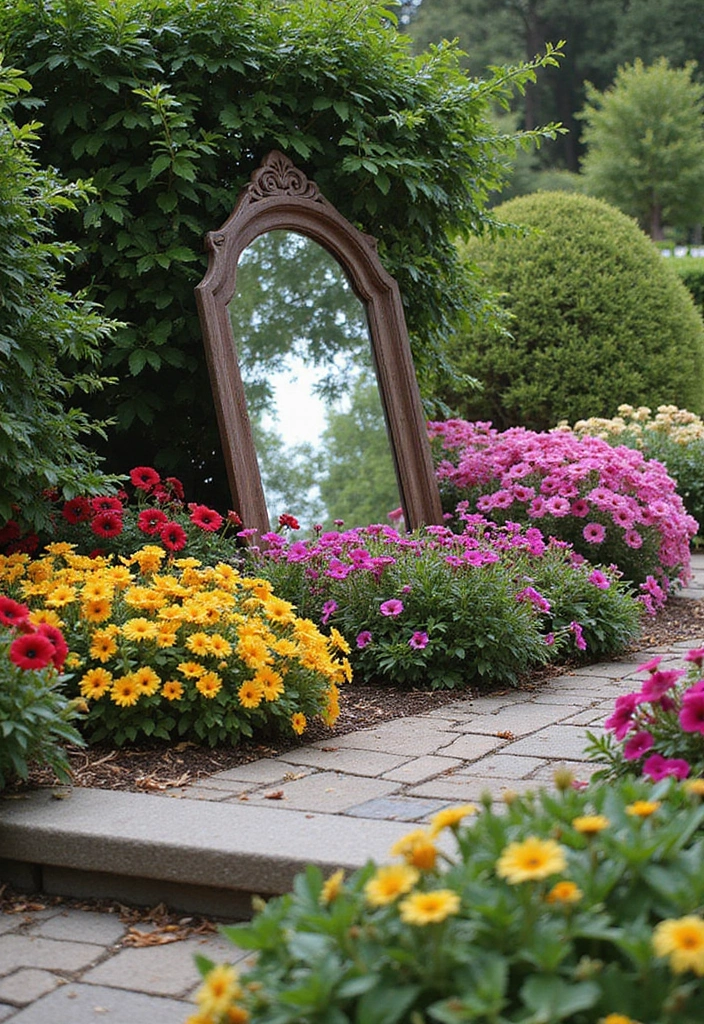
Incorporate mirrors or reflective surfaces into your flower bed design for a reflective retreat effect.
This can make your space feel larger and add depth to your garden.
Surround the mirrors with colorful flowers like petunias and snapdragons that can bounce light beautifully.
Ensure the seating area interacts with the reflections for a serene experience.
Suggestions:
– Use weather-resistant materials for durability.
– Consider various heights to maintain interest.
– Be mindful of sunlight angles for ideal reflections.
This approach will create a magical ambiance in your garden.
28. Fantasy Foliage
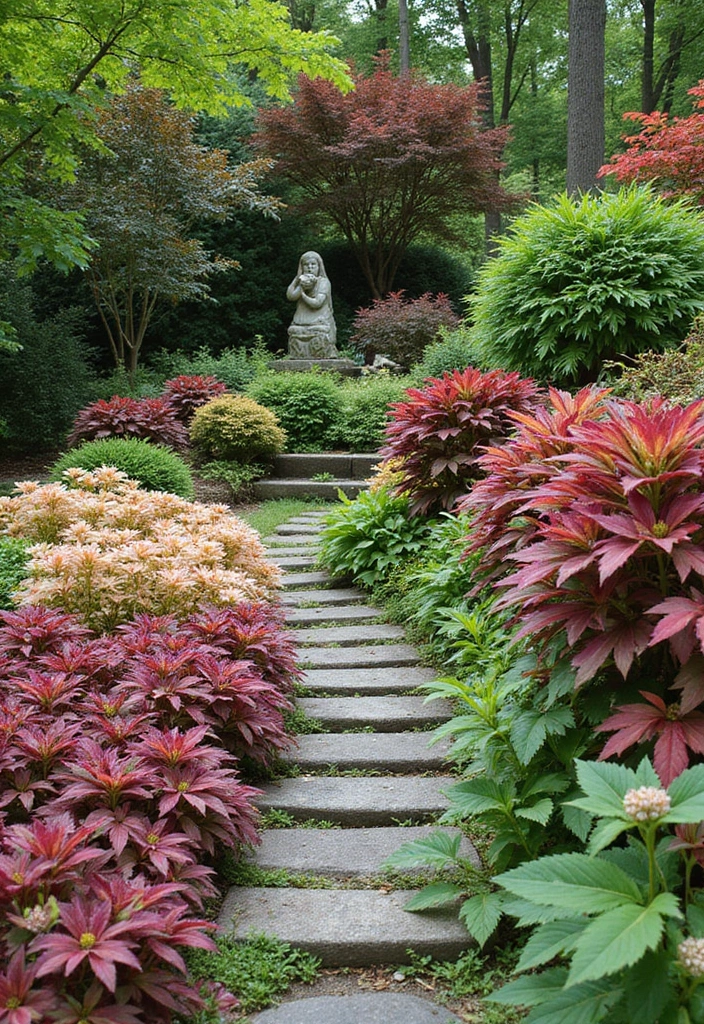
Focus on foliage with a fantasy foliage theme by highlighting the beauty of colorful leaves.
Choose vibrant plants like coleus, Japanese maples, and hostas that add visual interest even when not blooming.
Arrange a mix of colors and textures to create a lush, layered effect.
Consider adding decorative stones or sculptures to highlight the foliage.
Suggestions:
– Choose varying sizes of plants for depth.
– Use a harmonious color palette for cohesion.
– Incorporate seasonal changes in foliage for continued interest.
This design will emphasize the beauty of your garden year-round.
29. Vibrant Vines

Incorporate vines into your flower bed design for an inviting appeal.
Climbing plants like sweet peas, clematis, and honeysuckle can add height and drama.
Consider placing trellises or archways to allow vines to climb and create a focal point.
Mix these with ground cover plants for depth and visual dynamics.
Tips:
– Ensure sturdy supports for your vines.
– Regularly pruned for healthier growth.
– Choose colors that complement your garden theme.
This approach will provide added verticality and vibrancy to your garden.
30. Seasonal Showcases
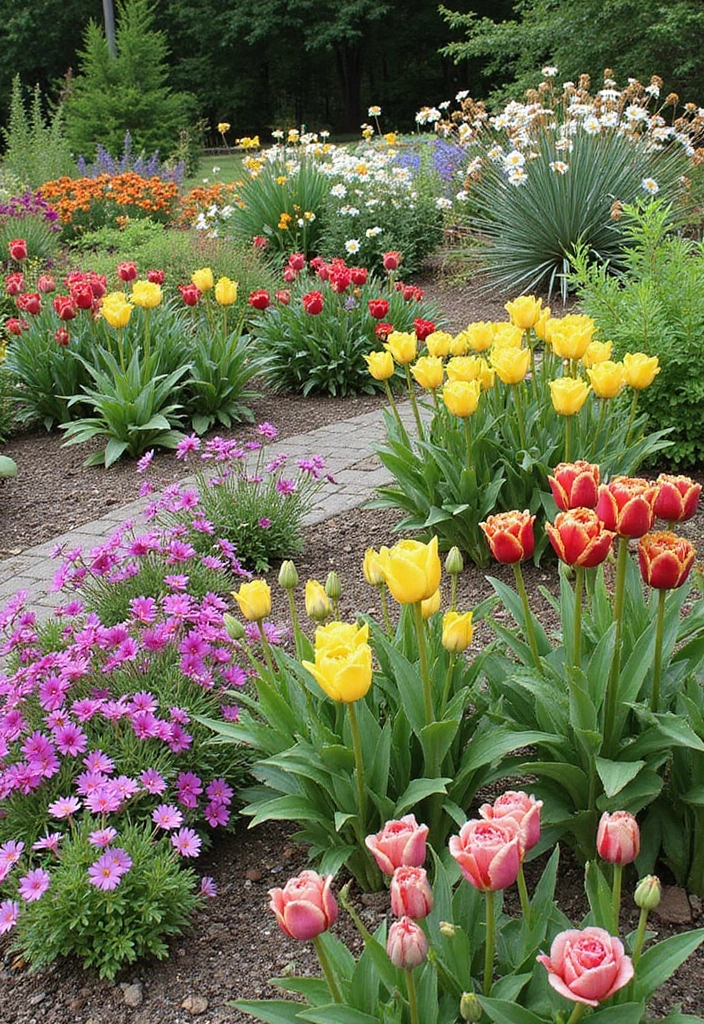
Create seasonal showcases in your flower beds by rotating plants based on blooming cycles.
Consider using perennials that bloom at different times and incorporate some annuals for immediate impact.
Design your layout to allow for effortless changes and replanting every season while maintaining a cohesive look throughout the year.
This creates a constantly evolving display, showcasing the beauty of each season.
Suggestions:
– Keep a seasonal calendar for planting schedules.
– Use markers to indicate where each plant will be located.
– Plan for seasonal colors that complement each other.
Your flower bed will always be a showstopper, no matter the time of year.
Conclusion: Garden Flower Beds to Brighten Your Space
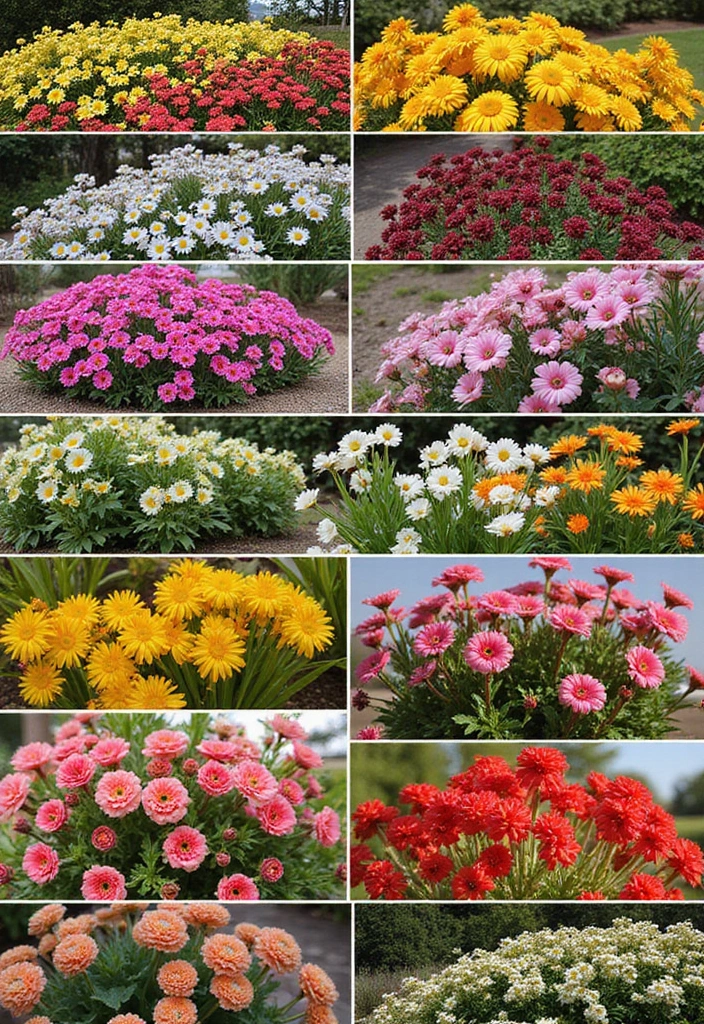
Creating stunning garden flower beds filled with color and texture is a rewarding experience.
With these ideas, you can design low-maintenance layouts that brighten not only your yard but also your mood.
Experiment with plants and arrangements that speak to you, and don’t shy away from creativity!
Your garden can be a sanctuary filled with joy, beauty, and the vivid colors of nature.
Frequently Asked Questions
What Are Some Easy Perennials for a Low-Maintenance Flower Bed?
If you’re aiming for a vibrant garden without the upkeep, consider easy-to-grow perennials like daylilies, coneflowers, and salvias. These plants not only add color but also thrive with minimal care, making them perfect for a low-maintenance flower bed.
By selecting these hardy varieties, you can enjoy a beautiful landscape that comes back year after year without the fuss!
How Can I Use Color Theory to Design My Flower Beds?
Using the color wheel can transform your garden into a stunning visual masterpiece! Start with a dominant color scheme, like bold reds and yellows, and mix in complementary colors for added depth.
Experiment with various shades and textures to create a harmonious look that draws the eye and brings joy to your outdoor space.
What Are Some Good Seasonal Flower Arrangements for My Garden?
To keep your garden blooming throughout the year, consider creating seasonal flower arrangements. Start with early bloomers like tulips and daffodils in spring, followed by summer favorites like lavender and echinacea, and wrap up with autumn beauties such as chrysanthemums.
This strategy ensures your flower beds are always vibrant and welcoming, no matter the season!
How Can I Incorporate Edible Plants into My Flower Beds?
Mixing beauty with functionality is a fantastic way to enhance your garden! Incorporate edible plants like nasturtiums, herbs, and strawberries alongside your ornamental flowers.
This not only provides fresh ingredients for your kitchen but also adds unique textures and colors to your flower beds, creating an inviting and productive space.
What Are the Benefits of Using Container Gardens for Flowers?
Container gardening is a versatile and creative way to add color to your yard! They allow for easy rearrangement based on seasons or moods, making it simple to refresh your space with a mix of annuals and perennials.
Plus, containers can be placed in sunny spots or shaded areas where traditional flower beds might struggle, giving you the flexibility to showcase your favorite blooms wherever you desire!

